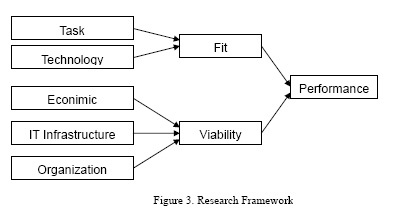Difference between revisions of "Fit-Viability theory"
m (1 revision: Dump from York) |
m (Text replace - "thumb|right|134px|[http://http://www.prin.edu// Site sponsor] thumb|right|134px|[http://www.yorku.ca/ Site sponsor]" to "") |
||
| Line 1: | Line 1: | ||
[[Image:AIS.jpg|thumb|right|134px|This site is associated with [http://www.aisworld.org/ AISWorld]]] | [[Image:AIS.jpg|thumb|right|134px|This site is associated with [http://www.aisworld.org/ AISWorld]]] | ||
| − | + | ||
| − | |||
== '''Fit-Viability theory''' == | == '''Fit-Viability theory''' == | ||
---- | ---- | ||
Revision as of 17:41, 26 October 2011
Fit-Viability theory
Fit and viability are two main concepts that are considered to be affecting the performance of technology adoption in organizations. This is an extension of the task-technology fit model (Goodhue and Thompson, 1995) at the individual level analysis of technology usage.
Acronym
FVM
Alternate name(s)
Fit-Viability Model, Fit-Viability Framework
Main dependent construct(s)/factor(s)
Performance
Main independent construct(s)/factor(s)
Fit, Viability
Concise description of theory
The model was originally proposed by Tjan in 2001 for evaluating organizational adoption of Internet intiatives. It includes two dimensions. One is fit and the other is viability. Fit measures the extent to which new network applications are consistent with the core competence, structure, value and culture of organization. Viability measures the extent to the value-added potential of new network applications, requirements of human resource, capital needs and so on. It proposes four generic strategies based on levels of fit and viability: invest, redesign, sell/spin out, and kill.
This model was later adapted to assess the adoption of mobile commerce technologies (Liang and Wei, 2004; Liang et al, 2007; O'Donnell, et al., 2007). In the revised model, the fit dimension measures the extent to which the feature of a technology matches the needs of the task. The viability refers to the extent to which the infrastructure of the organization is ready for adopting the technology. This needs to consider the general economic feasibility, technical infrastructure and the social readiness of the organization. In fact, many organizational factors have been identified to be critical to the success of IT implementation.
Diagram/schematic of theory
Originating author(s)
A. K. Tjan (2001)
Seminal articles
Tjan, A.K. (2001), “Finally, a way to put your internet portfolio in order”, Harvard Business Review, Vol. 79 No. 2, pp. 76-85.
Originating area
Information systems, business strategy
Level of analysis
Organization
IS articles that use the theory
Liang, T.P. and Wei, C.P.,"Introduction to the special issue: a framework for mobile commerce applications," International Journal of Electronic Commerce, Vol. 8 No. 3, 2004, pp. 7-17
Liang, T.P., Huang, C.W., Yeh, Y.H. and Lin, B.S., "Adoption of Mobile Technology in Business: a Fit-Viability Model," Industrial Management and Data Systems, Vol. 107, No. 8, 2007,pp. 1154-1169.
O'Donnel, J., Jackson, M., Shelly, M. and Ligertwood, J., "Australian Case Studies in Mobile Commerce," Journal of Theoretical and Applied Electronic Commerce Research, Vol.2, No. 2, 2007, pp. 1-18.
Tjan, A.K. (2001), “Finally, a way to put your internet portfolio in order”, Harvard Business Review, Vol. 79 No. 2, pp. 76-85.
Links from this theory to other theories
Task-technology fit, Information systems success, Fit-appropriation model
External links
Original Contributor(s)
Ting-Peng Liang
Please feel free to make modifications to this site. In order to do so, you must register.
Return to Theories Used in IS Research
